汉字笔画英文详解
- 格式:pdf
- 大小:5.56 MB
- 文档页数:58
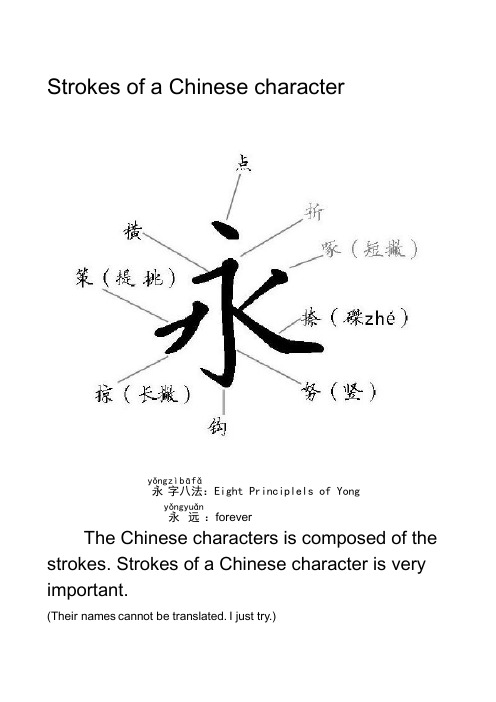
Strokes of a Chinese character永y ǒng 字z ì八b ā法f ǎ:Eight Principlels of Yong永y ǒng 远yu ǎn :foreverThe Chinese characters is composed of the strokes. Strokes of a Chinese character is very important.(Their names cannot be translated. I just try.)精选文档 点di ǎn ——dot , 即j ítiny dash 。
横h éng——horizontal ,即rightward stroke 。
竖sh ù——vertical ,即downward stroke 。
撇pi ě——throw away OR left-falling ,即falling leftwards ,withslight curve ,not very curved 。
捺n à——press down OR right-falling ,即falling rightwards, flattening at the bottom 。
提t í——rise OR rising ,即flick up and rightwards ,taper 。
撇点pi ědi ǎn ——throw away - dot竖提sh ùt í——vertical – rise折——break OR turning ,即90 degree turn ,going down or going right only 。
横折提h éngzh ét í——horizontal- break- rise 弯w ān——bend ,即usually concave on the left 。

26个英文字母手写体笔顺及占格
26个英文字母手写体笔顺及占格
1.书写笔顺
一笔完成的有:C,G,J,L,O,S,V,W,Z 9个大写字母和a,b,c,d,e,g,h,k,l,m,n,o,p,q,r,s,u,v,w,y,z 21个小写字母。
两笔完成的有:B,D,K,M,P,Q,R,T,U,X,Y等11个大写字母和f,i,j,t,x 等5个小写字母。
三笔完成的有:A,E,F,H,I,N等6个大写字母。
2.书写规格
占上中两格的有:26个大写字母和b,d,h,i,k,l,t等7个小写字母。
占中间一格的有:a,c,e,m,n,o,r,s,u,v,w,x,z等13个小写字母。
占中下两格的有: g,q,y等3个写字母。
占上中下三格的有: f,j,p等3个小写字母。
注意:
1.斜体书写的字母都稍向右斜,斜度要一致。
2.大写字母都一样高,不顶第一线。
3.小写字母 b,d,h,k,l 的上端顶第一线。
4.i 和 t 的上端都在第一格的中间。
5.g,q,y的下端抵第四线。
6.j 和 p 的上端在第一格的中间。
7.f 要比j,p要高,与大写字母同样高或稍低一些,它们的下端都抵第四线。
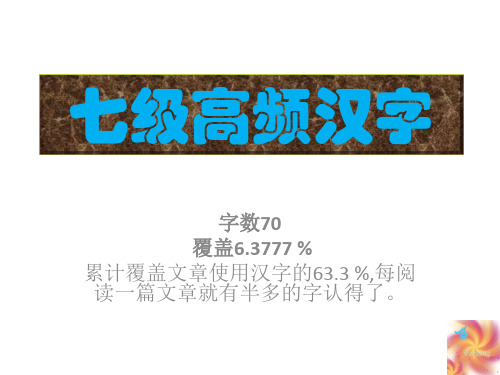
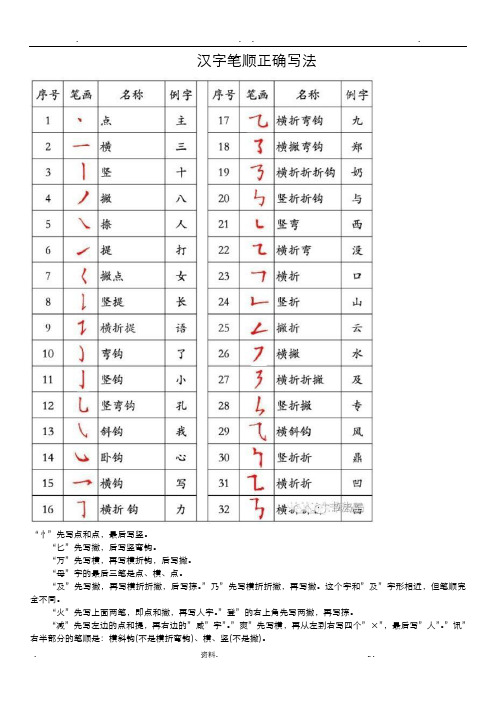
汉字笔顺正确写法“忄”先写点和点,最后写竖。
“匕”先写撇,后写竖弯钩。
“万”先写横,再写横折钩,后写撇。
“母”字的最后三笔是点、横、点。
“及”先写撇,再写横折折撇,后写捺。
”乃”先写横折折撇,再写撇。
这个字和”及”字形相近,但笔顺完全不同。
“火”先写上面两笔,即点和撇,再写人字。
”登”的右上角先写两撇,再写捺。
“减”先写左边的点和提,再右边的”咸”字”。
”爽”先写横,再从左到右写四个”×”,最后写”人”。
”讯”右半部分的笔顺是:横斜钩(不是横折弯钩)、横、竖(不是撇)。
“凸”第一笔先写左边的竖,接着写短横和竖,然后写横折折折,最后写下边的长横。
“凹”第一笔先写左边的竖,接着写横竖折,然后写竖和横折,最后写下边的长横。
“出”先写竖折,然后写短竖,再写中间从上到下的长竖,最后是竖折和短竖。
“贯”上边是先写竖折,再写横折,第三笔写里面的竖,最后写长横。
“重”上面的撇和横写后,紧接着写日,再写竖,最后写下面两横(上短下长)。
“脊”字上边的笔顺是先写左边的点和提,再写右边的撇和点,最后写中间的人。
“义”先写点,再写撇和捺。
点在上边或左上边的要先写,如”门、斗”等;点在右边或字里面的要后写,如”玉、瓦”等。
“匚”形字,先写”匚”上面的横,然后写”匚”里面的部分,最后才写”匚”最后的折,例如”匹、区、臣、匠、匣、匿”等。
“敝”的左边先写上部的点、撇,接着写左下角的竖、横折钩,然后写中间的长竖,最后写里面的撇、点。
这些字还有”弊、蹩、憋、鳖”等。
”噩”字的横、竖写后,接着写上边的左右两个”口”,再写中间的横和横下的两个”口”,最后写一长横。
这样写符合从上到下、先中间后两边的规则,与”王”字的笔顺不同。
附:笔画笔顺易错字集锦一、横1,末笔写二冉(再、苒)–笔顺:竖、横折钩、中竖、末笔写二。
里(理、童)–笔顺:先写甲,后写二。
重(踵、董)–笔顺:撇、横、写曰,中竖、再写二。
垂(捶、棰、锤)–笔顺:先写千、后写艹,再写二。
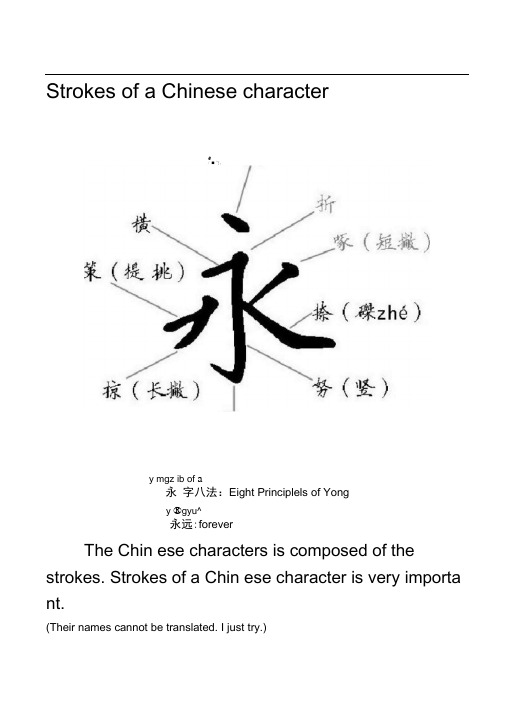
Strokes of a Chinese character占/ ■ "!、y mgz ib of a永字八法:Eight Principlels of Yongy ®gyu^永远:foreverThe Chin ese characters is composed of the strokes. Strokes of a Chin ese character is very importa nt.(Their names cannot be translated. I just try.)折 --- break ORturning ,即 90 degree turn , going downor going right only 。
h engzh & i 横折提 ---- horiz on tal- break- risewoi弯 --- b en d , 即 卩 usually con cave on the leftsh iwaig cu竖弯钩 ---- vertical- bend- hookxi e斜 --- s la nt ,即 usually con cave on the right1即tinydi d n 点 ----dot , h e g横 ---- horizontal ,即 rightward stroke 。
sh u竖 --- vertical ,即 downward stroke 。
throw away OR left-falli ng,即 falling leftwards , withslight curve , not very curved 。
n a 捺 -- press dow n OR right-falli,即 falling rightwards,flattening at the bottomt i 提 -- rise OR rising ,即 flick up and rightwards , taper 。
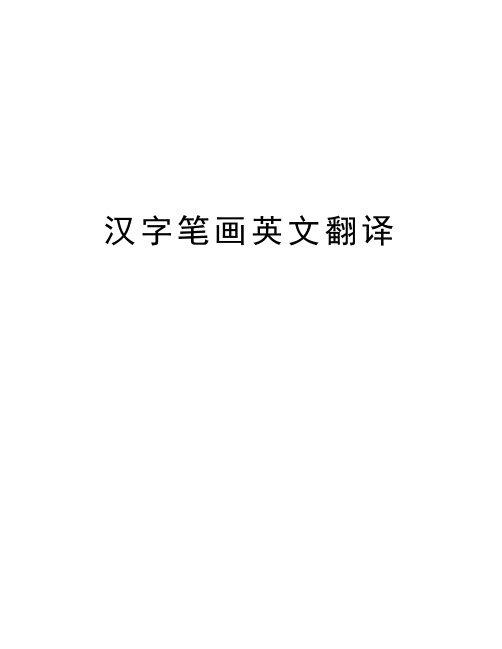
汉字笔画英文翻译Strokes of a Chinese character永y ǒng 字z ì八b ā法f ǎ:Eight Principlels of Yong永y ǒng 远yu ǎn :foreverThe Chinese characters is composed of thestrokes. Strokes of a Chinese character is very important.(Their names cannot be translated. I just try.)点di ǎn ——dot , 即j ítiny dash 。
横h éng——horizontal ,即rightward stroke 。
竖sh ù——vertical ,即downward stroke 。
撇pi ě——throw away OR left-falling ,即falling leftwards ,withslight curve ,not very curved 。
捺n à——press down OR right-falling ,即falling rightwards, flattening at the bottom 。
提t í——rise OR rising ,即flick up and rightwards ,taper 。
撇点pi ědi ǎn ——throw away - dot竖提sh ùt í——vertical – rise折——break OR turning ,即90 degree turn ,going down or going right only 。
横折提h éngzh ét í——horizontal- break- rise 弯w ān——bend ,即usually concave on the left 。
48个基本笔画可复制粘贴英文回答:The 48 basic strokes are essential for anyone learning to write Chinese characters. These strokes are the building blocks of the characters and understanding them is crucial for proper character formation. Here are the 48 basic strokes:1. Horizontal stroke: 一(yī)。
2. Vertical stroke: 丨(gǔn)。
3. Left-falling stroke: 丿(piě)。
4. Right-falling stroke: ㇏(héng)。
5. Dot: 丶(diǎn)。
6. Hook: 乛(gōu)。
7. Horizontal hook: 乚(yǐ)。
8. Vertical hook: 乙(yǐ)。
9. Left hook: 乜(miē)。
10. Right hook: 乛(gōu)。
11. Left-slanting stroke: 乙(yǐ)。
12. Right-slanting stroke: 乙(yǐ)。
13. Left-falling and right-slanting stroke: 乛(gōu)。
14. Right-falling and left-slanting stroke: ㇏(héng)。
15. Left-falling and left-slanting stroke: 丿(piě)。
16. Right-falling and right-slanting stroke: 一(yī)。
17. Horizontal and vertical stroke: 十(shí)。
英语字母笔顺规则。
123英语字母也称拉丁字母,是全世界的国家和民族都要学习使用的字母。
全世界相当多的国家4都是使用拉丁字母作文字字母。
没有使用拉丁字母作文字的国家,其数理化的符号也要使用5拉丁字母。
我国的汉语拼音语也是使用拉丁字母。
6拉丁字母的笔顺规则只三句话:71.上下关系,从上到下。
82.左右两种,从左到右。
93.点和中横后写。
1011第一句话:上下关系,从上到下。
是指笔画之间是上下关系的,笔顺要从上到下写。
如字母12“I、T”。
具体笔顺见下图。
1314第二句话:左右两种,从左到右。
有两个意思:15一是“左右”,指笔画之间是左右关系的,笔顺要从左到右写。
如字母“B、D”。
具体笔顺见16下图。
17二是“两种”,指笔画之间既有“上下关系”,又有“左右关系”这样的两种关系。
如字母“F”,18上部的“横”与左部的“竖”,其笔画之间的关系就是两种关系。
“横”在“竖”的上面,是上下关19系;“竖”在“横”的左面,是左右关系。
字母“q、d、P”和“E”中的首两笔之间的关系都是两种20关系。
两种关系的笔画,只依据其左右部分的关系来确定笔顺“从左到右”写。
如字母“F”中21的首两个笔画是两种关系,依据其左右部分的关系“从左到右”写,其笔顺就是“先竖后横”。
22具体笔顺见下图。
2324第三句话:点和中横后写。
有两个意思:25一是“点”。
有“点”的字母,“点”要在该字母的最后写。
如字母“i、j”。
具体笔顺见下图。
26二是“中横”。
“中横”是指在“上、中、下”位置中,处于中部位置的“横”,既包括不交叉的字27母“AEFH”中部的“横”,也包括交叉的字母“f t”中部的“横”。
有“中横”的字母,“中横”要在该28字母的最后写。
具体笔顺见下图。
29此外,以上没有明确的交叉的笔画,只依据其两个笔画“起笔点”的位置关系来确定笔顺。
30如“X”,只依据两个笔画“起笔点”在位置上的左右关系来确定笔顺从左到右。
具体笔顺见下图。
313233对于第二句话:“左右两种,从左到右”。
“声母、笔画、偏旁”这些词用英语怎么说在汉语教学中,不鼓励过多使用英语,但是一些汉语专有的术语,汉语老师还是应该掌握哦。
汉语语言学中术语中英文对照汉语英语声母initial韵母final单韵母single vowel final复韵母compound final鼻韵母nasal final声调tone音节syllable送气aspirated不送气unaspirated清音voiceless浊音voiced声调符号tone mark一声1st tone/high flat tone二声2nd tone/rising tone三声3rd tone/turning tone四声4th tone/falling tone轻声neutral tone舌尖the tip of the tongue舌面the blade of the tongue舌根the root of the tongue圆唇音round shape lip变调tone sandhi拼写spelling圆唇元音rounded vowel展唇元音unrounded vowel卷舌音retroflex笔画stroke笔顺stroke order偏旁radical/component先横后竖Héng proceeds Shù先撇后捺Piě proceeds Nà从上到下From up to down从左到右From left to right先外后内From outside to inside先外后内再封口First enclosing strokes,then inner strokes,finally Héng at the bottom独体字single-part characters合体字compound characters左右结构left-and-right structure上下结构up-and-down structure半包围结构 half-enclosure structure全包围结构 enclosure structure品字结构structure like “品”象形字pictographic character形声字idea-sound character形旁idea component声旁sound component会意字assocaitive compound characters 简体字simplified Chinese character繁体字traditional Chinese character。
Strokes of a Chinese character永y ǒng 字z ì八b ā法f ǎ:Eight Principlels of YongThe Chinese characters is composed of the strokes. Strokes of a Chinese character is very important.(Their names cannot be translated. I just try.)点di ǎn ——dot , 即j ítiny dash 。
六横h éng——horizontal ,即rightward stroke 。
大竖sh ù——vertical ,即downward stroke 。
十撇pi ě——throw away OR left-falling ,即falling leftwards ,with slight curve ,not very curved 。
八捺n à——press down OR right-falling ,即falling rightwards, flattening at the bottom 。
八提t í——rise OR rising ,即flick up and rightwards ,taper 。
地撇点pi ědi ǎn ——throw away - dot 女竖提sh ùt í——vertical – rise 比折——break OR turning ,即90 degree turn ,going down or going right only 。
横折提h éngzh ét í——horizontal- break- rise 讲 弯w ān——bend ,即usually concave on the left 。